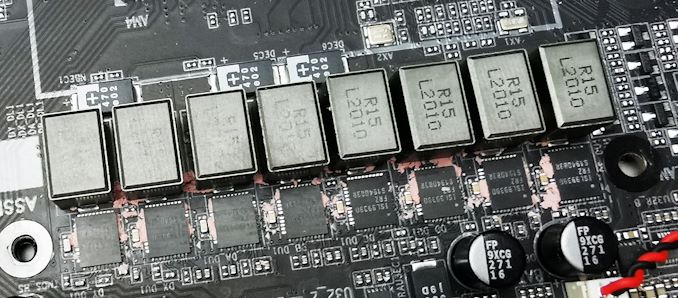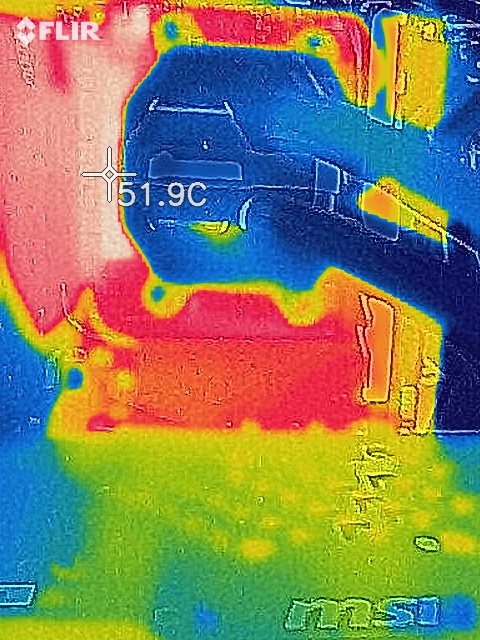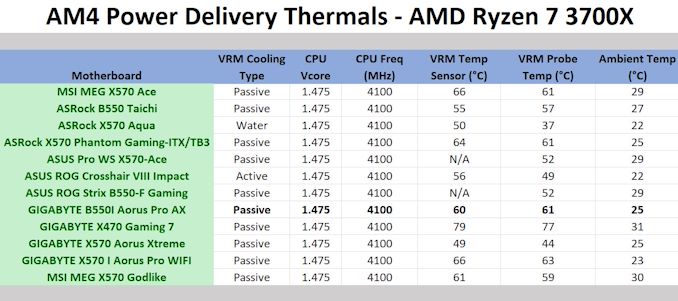The GIGABYTE B550I Aorus Pro AX Motherboard Review: All The Small Things
by Gavin Bonshor on December 7, 2020 10:00 AM ESTPower Delivery Thermal Analysis
One of the most requested elements of our motherboard reviews revolves around the power delivery and its componentry. Aside from the quality of the components and its capability for overclocking to push out higher clock speeds which in turn improves performance, is the thermal capability of the cooling solutions implemented by manufacturers. While almost always fine for users running processors at default settings, the cooling capability of the VRMs isn't something that users should worry too much about, but for those looking to squeeze out extra performance from the CPU via overclocking, this puts extra pressure on the power delivery and in turn, generates extra heat. This is why more premium models often include heatsinks on its models with better cooling designs, heftier chunks of metal, and in some cases, even with water blocks.

The 8-phase power delivery operating at 6+2 on the GIGABYTE B550I Aorus Pro AX
Testing Methodology
Out method of testing out if the power delivery and its heatsink are effective at dissipating heat, is by running an intensely heavy CPU workload for a prolonged method of time. We apply an overclock which is deemed safe and at the maximum that the silicon on our AMD Ryzen 7 3700X processor allows. We then run the Prime95 with AVX2 enabled under a torture test for an hour at the maximum stable overclock we can which puts insane pressure on the processor. We collect our data via three different methods which include the following:
- Taking a thermal image from a birds-eye view after an hour with a Flir Pro thermal imaging camera
- Securing two probes on to the rear of the PCB, right underneath CPU VCore section of the power delivery for better parity in case the first probe reports a faulty reading
- Taking a reading of the VRM temperature from the sensor reading within the HWInfo monitoring application
The reason for using three different methods is that some sensors can read inaccurate temperatures, which can give very erratic results for users looking to gauge whether an overclock is too much pressure for the power delivery handle. With using a probe on the rear, it can also show the efficiency of the power stages and heatsinks as a wide margin between the probe and sensor temperature can show that the heatsink is dissipating heat and that the design is working, or that the internal sensor is massively wrong. To ensure our probe was accurate before testing, I binned 10 and selected the most accurate (within 1c of the actual temperature) for better parity in our testing.
For thermal image, we use a Flir One camera as it gives a good indication of where the heat is generated around the socket area, as some designs use different configurations and an evenly spread power delivery with good components will usually generate less heat. Manufacturers who use inefficient heatsinks and cheap out on power delivery components should run hotter than those who have invested. Of course, a $700 flagship motherboard is likely to outperform a cheaper $100 model under the same testing conditions, but it is still worth testing to see which vendors are doing things correctly.
Thermal Analysis Results

We measured 51.9°C on the hottest part of CPU socket area during our testing
The GIGABYTE B550I Aorus Pro AX is using an 8-phase design that operates in a 6+2 configuration. It consists of six Intersil ISL99390 90 A power stages for the CPU VCore, and two ISL99390 90 A power stages for the SoC. (insert doubler). Cooling the power delivery is a large single heatsink that molds into the design of the board's plastic rear panel cover and is connected to the M.2 and chipset heatsink. It relies primarily on brute mass and good passive airflow within a chassis.
Looking at the GIGABYTE B550I Aorus Pro AX's power delivery thermal results in comparison to other AM4 models we've tested with our Ryzen 7 3700X processor, it performs pretty well all things considered. We typically see higher temperatures on mini-ITX motherboards which is a direct result of cramped componentry on a small PCB. Where an ATX size model can utilize PCB space to split power deliveries into two elements with one to two heatsinks to dissipate the heat more effectively, the GIGABYTE power delivery operates in a single strip with a single heatsink doing all of the heat removal.
We observed a reading of 61°C from our first K-type probe on the rear, with our second consistent with a slight variance of 59°C. This is also consistent with the reading from the board's VRM temperature sensor of 61°C, which shows the heatsink is efficiently removing heat as our thermal imaging camera shows the hottest part around the socket reached just shy of 52°C. This is good for a mini-ITX model and it shows GIGABYTE has another highly efficient power delivery design on its hands.











76 Comments
View All Comments
romrunning - Monday, December 7, 2020 - link
This board has been out for quite a while, and it's been proven to be a good buy. If you done any homework at all on mini-ITX B550 boards, you'll know it's one of the top ones.The main difference between this board and the other top competitors is that it doesn't have a Type-C front-panel port. That seems to be the main reason why it's a bit cheaper than the other boards. I can see Gigabyte adding it in a "v2" of the board, though. If your choice for a new mini-ITX case has that style of port available, it may factor into your decision.
gavbon - Monday, December 7, 2020 - link
Of course, I agree with you. It's why it's been highlighted as my go-to Mini-ITX model in our AMD motherboard guides.romrunning - Monday, December 7, 2020 - link
What's annoying is that we can get these great mini-ITX boards back in stock, but the rest of the new components are out of stock. My NR200 & this Gigabyte board was going to be the base of a new build, but everything else is not available. I'm not going to buy from over-priced eBay offers, so for now, patience is the key.Zagreus86 - Monday, December 7, 2020 - link
I'm in the same boat, except I have everything except the case at this point (NR200). Seems we can't get them into the UK for love nor money at the moment!Questor - Wednesday, December 9, 2020 - link
Where is my Ryzen 5900X? I swear it was right here just a minute ago. Did you see it?christinescoms - Saturday, December 12, 2020 - link
I get paid more than 120 to 130 per hour for working online. I heard about this job 3 months ago and after joining this i have earned easily 15k from this without having online working skills. This is what I do.....___bit.ly/googlework75calc76 - Monday, December 7, 2020 - link
Another big difference is how many high speed ports the Asus B550-I has vs the Gigabyte B550I has, not just the lack of front 10Gbps Type C. Gigabyte probably skimped to be cheaper there as well:Asus B550-I:
5 10Gbps
2 5Gbps
4 480Mbps
Gigabyte B550I:
2 10Gbps
6 5Gbps
2 480Mbps
mkarwin - Tuesday, December 15, 2020 - link
And another is how the "supreme surround sound" is done through analog outputs - Asus requires connecting 2 rear ports and front-panel line-out for 5.1 analog speakers, while Gigabyte utilises rear ports only...Quad5Ny - Friday, March 26, 2021 - link
When you see ONLY 3 audio ports on the rear these days its usually auto-switching. So you'll get 5.1 using the back panel and 7.1 if you use the back and front panel. -Skip the mic and line-in on the rear and consult your MB manual.ozark - Tuesday, December 8, 2020 - link
For this exact reason I op'ed for the MSI MPG B550I, which is listed for $200 but often on sale for $185 or lower on Amazon. When you are on an ITX build, every port is precious and a front panel USB-C port is immensely useful. It's bit a of shame that the MSI board uses slightly inferior setup for their audio or wifi solution, although for most people there's no detectable difference.